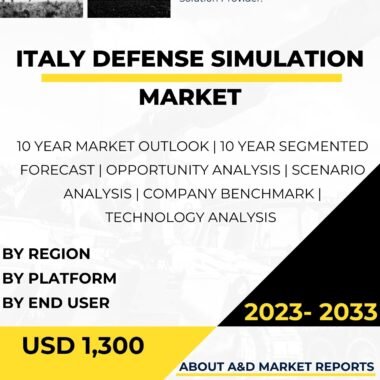Description
The Sweden Defense Training and Simulator Market plays a crucial and transformative role in the country’s defense industry, providing advanced training and simulation solutions to enhance the skills, readiness, and effectiveness of military personnel across all branches of the armed forces. As the security landscape continues to evolve, the need for well-trained and agile defense forces becomes increasingly paramount. To meet these challenges, defense training and simulation technologies have become indispensable tools, enabling defense forces to practice and refine their capabilities, test new strategies, and evaluate the performance of military equipment in a safe and controlled setting.
Training and simulation technologies in the Sweden Defense Training and Simulator Market create realistic and immersive environments that closely replicate real-world scenarios. These virtual environments allow military personnel to engage in various training exercises and combat simulations, offering a safe and cost-effective alternative to live exercises. From individual soldiers to joint forces, pilots, submariners, and specialized units, a wide array of defense personnel benefits from the extensive training opportunities provided by these technologies.
Individual soldier training lies at the heart of the Sweden Defense Training and Simulator Market. Virtual simulators and augmented reality (AR) technologies have revolutionized training for infantry units, providing soldiers with a safe yet challenging environment to hone their essential skills. Whether it’s marksmanship, tactical maneuvers, or decision-making under pressure, these simulations closely replicate the realities of combat, better preparing soldiers for real-world missions.
Collective and joint exercises involving multiple military units are equally critical in enhancing operational effectiveness. Simulation technologies create integrated virtual environments that enable land, air, and naval forces to train together, fostering interoperability and improving coordination between different branches of the armed forces. The ability to work cohesively in joint operations and coalition missions is vital to Sweden’s defense strategy, making these simulations invaluable for ensuring seamless cooperation.
In addition to land and air-based simulations, the Sweden Defense Training and Simulator Market addresses specialized training for pilots, submariners, and other specialized units. Flight simulators provide pilots with realistic flight experiences, allowing them to practice maneuvers and emergency procedures without risk to personnel or expensive aircraft. Similarly, submarine simulators create immersive environments for submariners to train in navigation, combat, and emergency scenarios, significantly enhancing their skills and preparedness for underwater missions.
The success of the Sweden Defense Training and Simulator Market can be attributed to a strong foundation of research and development (R&D) activities. Backed by government funding and research institutions, Sweden’s defense industry has been at the forefront of developing cutting-edge training and simulation technologies. Collaboration between the defense industry and the armed forces ensures that these solutions are tailored to meet specific military requirements and operational needs, contributing to the continuous evolution of the market.
The integration of emerging technologies has been a defining aspect of the Sweden Defense Training and Simulator Market. The adoption of virtual reality (VR) and augmented reality (AR) technologies has significantly enhanced the realism and effectiveness of simulation-based training. Soldiers benefit from high-fidelity training environments that closely resemble actual combat scenarios, maximizing the effectiveness of their training experiences.
Artificial intelligence (AI) and machine learning algorithms also play a pivotal role in enhancing training and simulation experiences. AI-driven virtual opponents and scenarios introduce dynamic and adaptive training experiences, simulating intelligent adversaries and unpredictable situations. These AI-powered simulations challenge soldiers and forces to adapt to changing environments and evolving threats, preparing them for the complexities of modern warfare.
The Sweden Defense Training and Simulator Market’s significance extends beyond the training of military personnel. These technologies also contribute to research and development (R&D) activities within the defense sector. Training and simulation systems enable experimentation and analysis of new strategies and concepts, allowing defense planners and decision-makers to assess potential outcomes and optimize resource allocation in defense planning and strategy formulation.
Furthermore, the market continues to advance in cybersecurity solutions, given the sensitive nature of the data generated and transmitted during training and simulation exercises. Ensuring the security and integrity of the simulation environment is essential to maintain confidentiality and safeguard classified information.
As the global security landscape continues to evolve, the future of the Sweden Defense Training and Simulator Market remains promising. The market’s ability to cater to diverse defense requirements while embracing technological advancements will ensure that Sweden’s defense forces remain equipped with cutting-edge training and simulation capabilities, enhancing the nation’s defense readiness and contributing to global security efforts. Continued research and development, international collaborations, and a commitment to innovation will further solidify Sweden’s position as a leading player in the global defense training and simulator market, ensuring its defense forces remain at the forefront of readiness and effectiveness in safeguarding the nation’s security.




